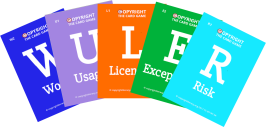Guest blog post by Chris Morrison 
When Katharine and Jo first asked me to write a chapter on copyright and its relationship with digital literacy for their book I was somewhat frantic and not sure I would be able to do it. This was largely because I was in the middle of doing a postgraduate diploma in copyright law at King’s College London whilst also keeping up with demands of the day job at the University of Kent. In addition to this I was also tearing around the country with Jane Secker spreading the word about copyright literacy and playing our copyright games with anyone who was interested.
But thanks to Katharine and Jo’s understanding on deadlines I did manage to find time to get my chapter written. I came up with the idea for the structure whilst Jane and I were on the train across to LILAC 2017 in Swansea and I literally wrote it down on a napkin. I’ve always thought that whole napkin/back of fag packet thing was a bit of a cliché, but it was helpful to get things written down visually without getting distracted by digital devices. Here’s what I came up with…

Here’s what I was getting at:
- “They infringe” Copyright provides exclusive rights to authors and producers for copying and communicating their works and the law includes penalties for those who use content without authorisation. However, digital technology makes it incredibly easy to infringe copyright. My sense was that when considering copyright many people are likely to be infringing unwittingly, and may believe that ‘fair use’ (more of which later) is a ‘get out of jail free card’.
- “Stop them” I think the natural tendency for those who are responsible for copyright in education, once they are aware of the potential consequences of using copyright material, is to try and shut down “non-compliant” activity that might trespass on those rights. But this can be problematic.
- “CC” A lot of people are aware that Creative Commons licences provide considerable freedoms for those wanting to build upon the works of others and share their own creativity. This for me was the beginning of the journey back in the direction where we started: somewhere not fundamentally about fear or prohibition. I believe Creative Commons licences are excellent and I’m a big fan of the way they’ve made sharing of copyright material simpler and more user friendly. However, I wanted to communicate the limitations of using only Creative Commons licensed material. Despite there being over a billion CC-licensed works, the complete range of artistic, cultural and scientific material which people might have a legitimate interest in using is many times greater than that. This was where I wanted to talk about the importance of copyright exceptions.
- “& Exceptions” (not sure why I wrote “2” next to this on the napkin). Exceptions are the defences you can rely on when you use other people’s copyright works without permission for societally beneficial purposes. Although they require a bit of understanding about how they work (e.g. in the UK we have ‘fair dealing’, not ‘fair use’ which operates in subtly different ways), they are a fundamentally important aspect of learning, teaching and creating new knowledge.
- “Citation and attribution” The end of the journey was to return to the beginning by way of stressing the importance of attribution and citation. Whilst this isn’t another ‘get out of jail free card’ it is almost always necessary to comply with the terms of a licence or to take advantage of a fair dealing (or fair use) defence. It seemed to me that in the end there is not necessarily a huge gap between what you may lawfully and ethically do with copyright material, and what many people believe they should be able to do. But to get there requires some understanding of the territory.
When I pitched this idea to Katharine at the LILAC conference dinner I think she looked a bit unsure at my slightly crazed rantings and the waving of the napkin [see footnote]. I think she might have said something along the lines of “and aren’t you going to mention your and Jane’s copyright games?”, to which I answered something along the lines of “yes, of course I was going to do that all along” even though for some reason I’d totally forgotten about them.
Anyway, you can now read the chapter available via Kent Academic Repository here as well as on the copyrightliteracy.org site. It includes all of the above as well as being Creative Commons licensed (CC-BY-NC). I’m very proud of the way it’s turned out, as well as the fact that it’s in such an excellent book with contributions from lots of very clever and talented people. I’d like to thank Jo and Katharine as well as Damian Mitchell from Facet for putting up with my forensic analysis of the contributors’ publishing agreement, and for selecting my chapter to be the one available on open access. And I’d also like to thank Jane for her help in getting it from napkin to final manuscript.


For those who would like to explore these issues in more detail, the call for contributions to Icepops 2019 has just been launched.
[editor note: I was struggling to hear about the enthusiastic hubbub of the festivities, and happy to hear any plan however crazed!]
